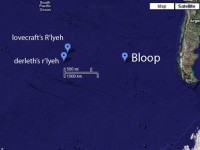
Science / Wikipedia03.04.2014
Bloop
The Bloop is the name given to an ultra-low-frequency and extremely powerful underwater sound detected by the U.S. National Oceanic and Atmospheric Administration (NOAA) in 1997. The sound is consistent with the noises generated by icequakes in large icebergs, or large icebergs scraping the ocean floor. The sound's source was roughly triangulated to 50°S 100°W Coordinates: 50°S 100°W (a remote point in the south Pacific Ocean west of the southern tip of South America), and the sound was detected several times by the Equatorial Pacific Ocean autonomous hydrophone array. According to the NOAA description, it "rises rapidly in frequency over about one minute and was of sufficient amplitude to be heard on multiple sensors, at a range of over 5,000 km." The NOAA's Dr. Christopher Fox did not believe its origin was man-made, such as a submarine or bomb, nor familiar geological events such as volcanoes or earthquakes. While the audio profile of Bloop does resemble that of a living creature,[2] the source was a mystery both because it was different from known sounds and because it was several times louder than the loudest recorded animal, the blue whale.